The botany of bamboo is a vast and diverse world of its own. The Bambusoideae subfamily of grasses includes nearly 100 genera and more than 1,200 species. And to the casual observer, the majority of these grasses look strikingly similar. But if you’re trying to wrap your mind around this multifarious conglomeration of ornamental plants, then perhaps the genus Phyllostachys is the best place to start.
Primarily native to Central and Southern China, the genus Phyllostachys includes some of the greatest variety and most widely grown species of bamboo in the world. As running bamboos, they have a tremendous capacity to multiply and proliferate. As temperate, cold hardy species, they have a remarkable ability to thrive in climates ranging from southern Canada to the tropics. The largest of Phyllostachys can grow more than 100 feet tall, while other cultivars are well suited for bonsai.
In the following article, we’ll examine the distinguishing characteristics of the genus Phyllostachys. This will help you identify these types of bamboo, and to decide whether they are right for your garden. We’ll also talk about the widespread cultivation and economic importance of these bamboo types. Finally, we’ll take a closer look at a few species in particular, focussing on the impressive diversity of this genus.
This article — first published in October 2020 and last updated in February 2025 — is part of an ongoing series about different types and species of bamboo. To learn more about this fascinating and diverse collection of grasses, check out these other articles.
- Running bamboo
- Clumping bamboo
- Genus Dendrocalamus: The biggest bamboos
- Genus Fargesia: Clumping bamboo for cold climates
- Oldhamii: Chinese timber bamboo
- Native bamboos of North America: Arundinaria
- Herbaceous bamboo: Olyreae
Characteristics of Phyllostachys
This genus of bamboo is indigenous to Asia, with most species originating somewhere in Southern or Central China. Based in these climates, most Phyllostachys are temperate bamboos, meaning that they can tolerate cold winters. Many of them are able to survive temperatures well below 0º F.
This makes the Phyllostachys especially popular in colder climates, like USDA zones 5 and 6. But most Phyllostachys are adaptable to warmer weather as well. So you can really find them flourishing all over the world. In fact, they are some of the most widespread and commonly cultivated bamboo species across North America, and also Europe and Australia.
Branches form at the nodal joint on alternating sides of the culms. In most cases, Phyllostachys will produce an uneven pair of branches at each node. Some species of Pseudosasa or Semiarundinaria, also running bamboos, can look pretty similar to Phyllostachys. But these bamboos usually have three or more branches at each node.

The word Phyllostachys has an exotic and sophisticated ring to it. You can use it to impress your neighbors when they ask about your garden. The name comes from Greek and means “leaf spike”, referring to the flowering inflorescences, which are produced every so many decades.
Running rhizomes
Part of what makes the Phyllostachys so prolific, apart from their adaptability to the cold, are their running rhizome roots. A superior means of survival and propagation, these vigorous rhizomes can also be the scourge of many gardeners.
In sorting out your bamboos, the simplest classification is to divide them between runners and clumpers. Generally speaking, the runners are the temperate varieties of bamboo, including Phyllostachys, Pleioblastus, Chimonobambusa and Sasa, to name a few. Conversely, the clumpers mostly belong to the tropical and subtropical genera, such as Bambusa, Dendrocalamus, Guadua and Himalayacalamus. (Fargesia, a genus of temperate clumping bamboo, is the major exception to this rule.)
While clumping bamboo has pachymorph, sympodial rhizomes, which bunch together and grow upward in a u-shape, the running bamboos have what are called leptomorph or monopodial rhizomes. These grow parallel to the ground, outward and away from the main plant.
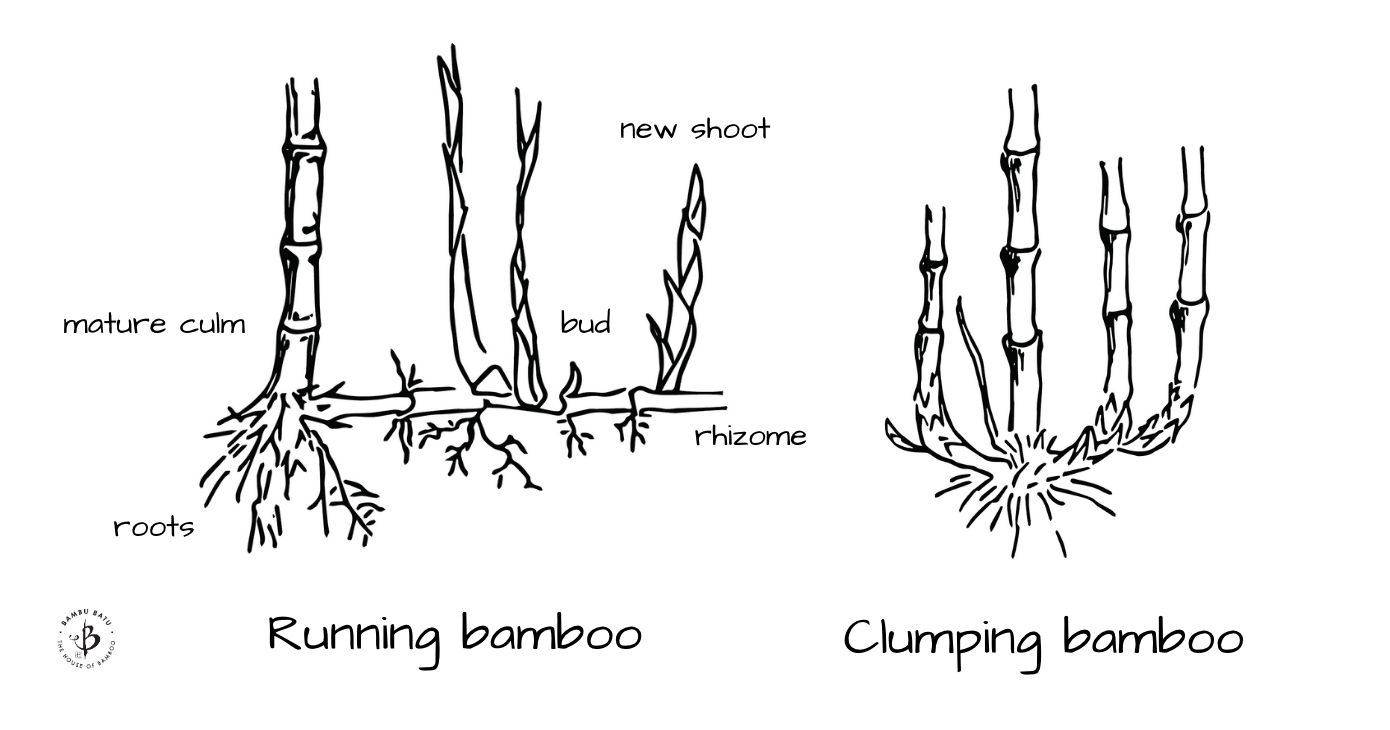
It is relatively easy to propagate a running bamboo by taking a cutting from a rhizome. The rhizomes have a tenacious will to live, and so they are widely available in nurseries around the world. But that tenacity can be a double-edged sword. Sometimes the bamboo can take over a garden and become invasive. And when the gardener wants to remove the bamboo, it can become a terrible challenge.
For this reason, we always encourage growers to bury a rhizome barrier around their running bamboos. These heavy-duty liners provide a very effective method of keeping the bamboo within a well-defined space. This allows you to maintain a long and thick privacy hedge, for example, without it spreading everywhere and wreaking havoc on your garden. And as it happens, Phyllostachys can be some of the most invasive bamboos of all.

Identifying Phyllostachys
If you’re worried about having an invasive bamboo in your yard, you’ll be relieved to know that Phyllostachys are actually some of the easiest bamboos to recognize. The most distinctive characteristic is the branching pattern. Like all bamboo, the branches form at the nodal joints, but with the genus Phyllostachys, there are always two dominant branches, and sometimes additional smaller branches. (See image above.) With the smaller members of the genus, the branching starts very low and close to the ground, but with the bigger species (like Moso and Henon) the branching starts much higher up on the culms.
Another distinguishing mark is a narrow indentation, called a sulcus groove, that runs along the internodes on alternating sides of the bamboo, above the branching node. Sometimes the groove is very pronounced, and in other cases it’s more subtle. But if you look closely you should be able to see it. It’s also visible on the rhizomes (see image above).
This is very useful to know, because if someone plants a running bamboo without realizing it, it can become a real catastrophe a few years down the road. It’s worth inspecting your neighbor’s bamboo patch, for example, as it approaches your property line. Also, if you’re not purchasing your plants from a bamboo specialty nursery, it’s not uncommon for bamboo to be mislabeled. Golden Bamboo (a running Phyllostachys aurea), for instance, can sometimes be sold as Golden Goddess (a clumping Bambusa multiplex).

Species of Phyllostachys
Although it’s one of the easiest bamboo genera to identify, Phyllostachys can come in a great variety of sizes and colors. There are around 50 species in the genus, not to mention a whole multitude of subspecies (cultivars). So we’ll just cover some of the most popular and important varieties here, beginning with four timber bamboos and then several smaller species.
Timber types
Phyllostachys bambusoides: Giant Japanese timber bamboo, or Madake, this variety can provide privacy all the way up to the second and third-story windows. Smooth, beautiful culms can get 50-70 feet tall, depending on conditions, with a culm diameter of up to 5″. Yes, they’re runners, but not terribly aggressive. Slower growing than other members of the genus, but among the most impressive in size, and probably the best Phyllostachys for building. Cold hardy down to 0º F, but they grow larger in warmer climates. They seem to do best in zones 7 and 8.
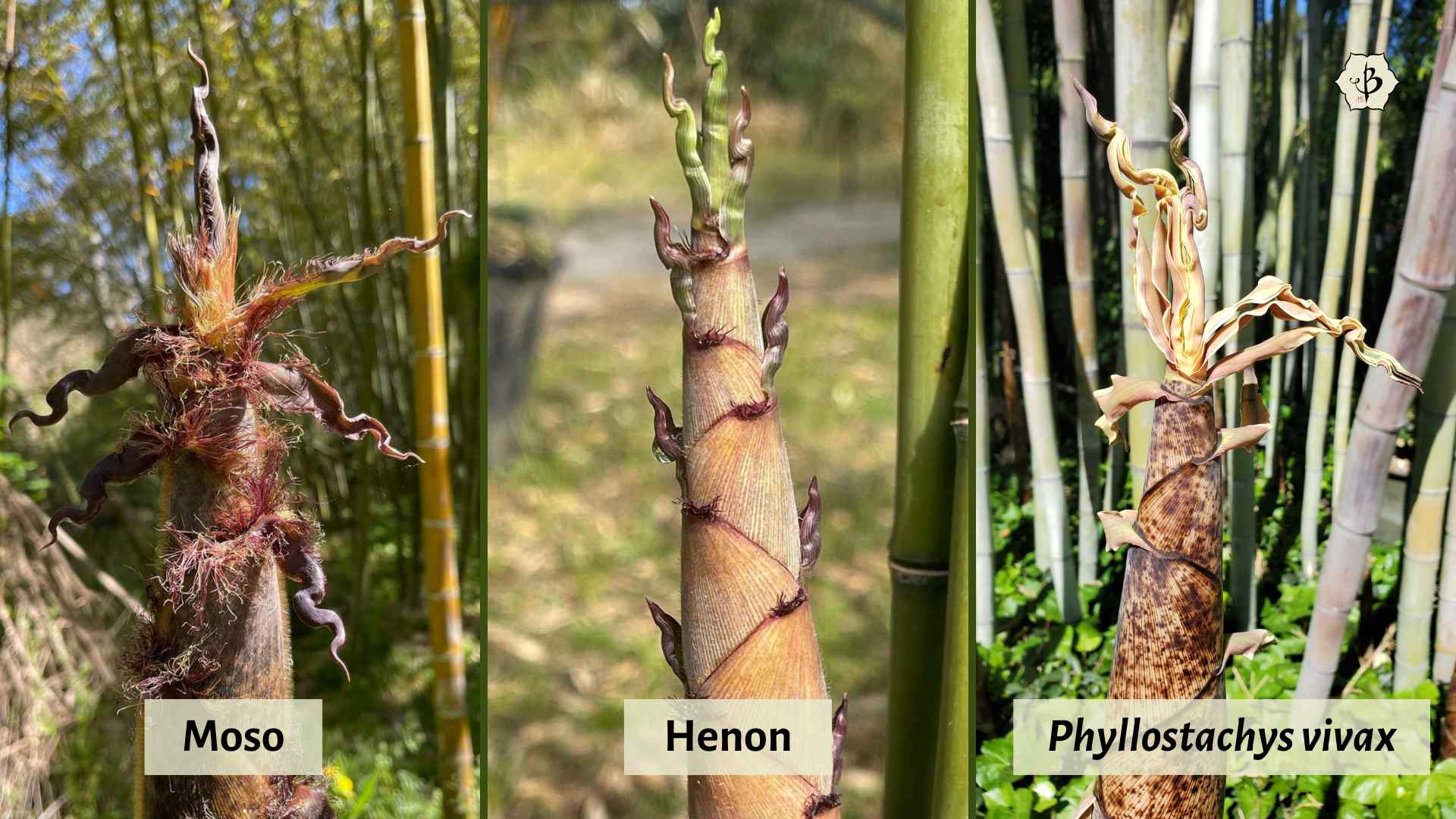
Phyllostachys edulis, or Moso Bamboo: Probably the most famous and most economically important bamboo species in the world, Moso is the source of raw material for all bamboo textiles, bamboo flooring and laminated bamboo kitchen wares. In its native China, this timber variety can exceed 100 feet in height. But outside of Asia it does not grow quite as well. There have been attempts to cultivate Moso commercially in Florida and the Deep South, but the results remain inconclusive. It’s not really a viable option west of the Mississippi.
As the name would suggest, Ph. edulis is also a popular species for eating. The young, tender shoots, when properly prepared, can be nutritious and delicious. (Ph. dulcis is also said to be quite tasty.) The cultivar, ‘Heterocycla’, better known as Tortoise Shell Bamboo, is a highly prized specimen for its beautifully shaped culms.
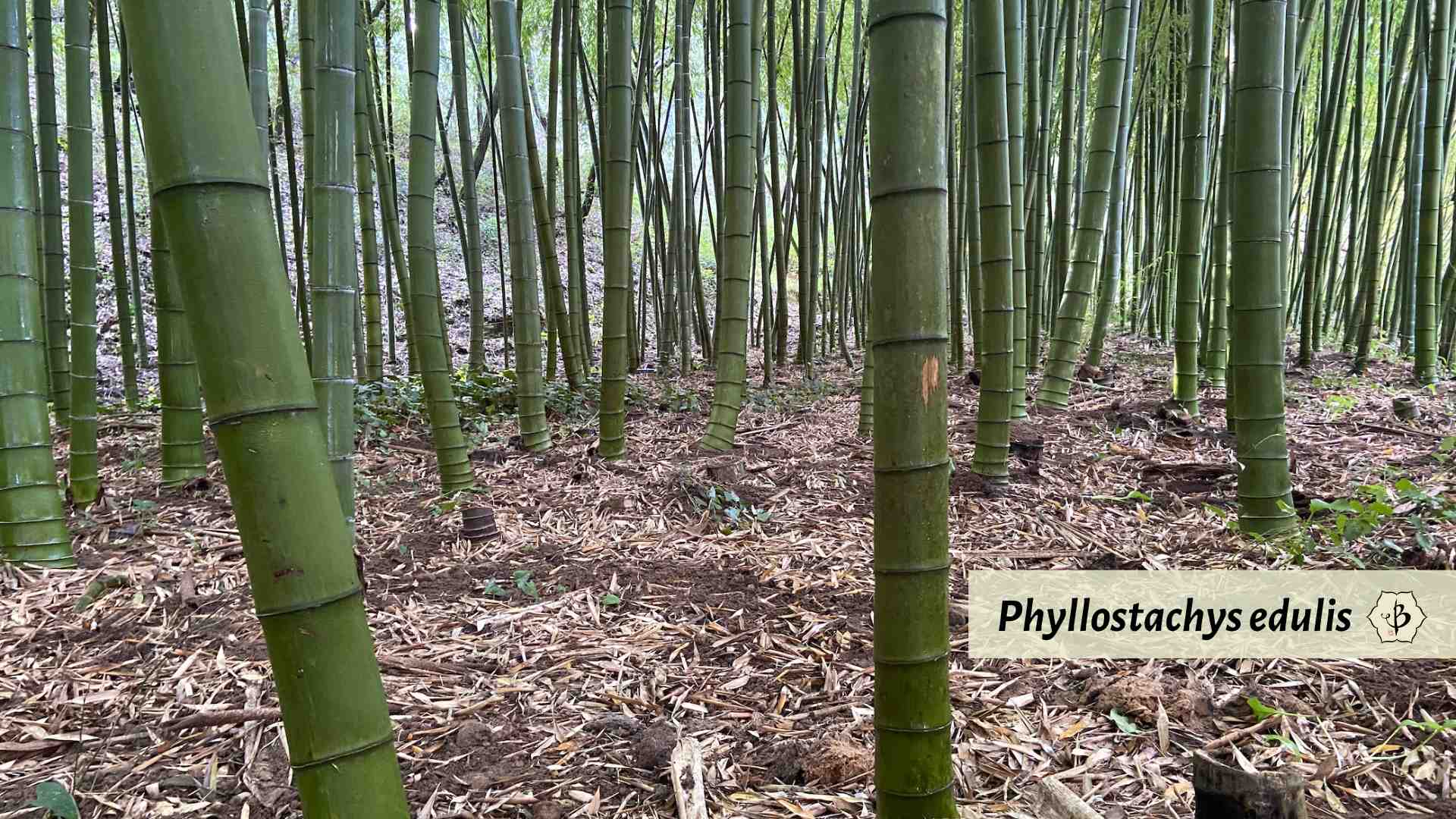
Phyllostachys nigra ‘Henon’: Giant Gray, as it’s known, is a cultivar and possibly the original species of Black Bamboo (see below). Unlike the common Ph. nigra, this variety has beautiful, towering, greenish-gray culms that can get up to 50 or 60 feet tall and more than 4 inches thick. This timber bamboo may not achieve the same diameter as bambusoides or vivax, but the culm walls are relatively thick, making it an excellent choice for building and light construction, among other uses. It also grows especially well in most climates of the United States, far more adaptable than Moso. Cold hardy to -5º or -10º F.
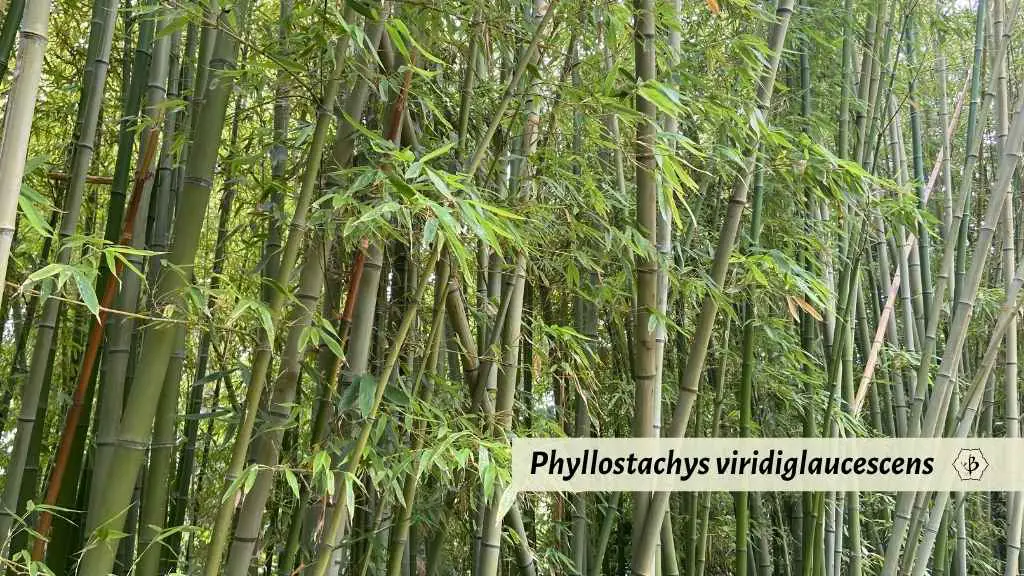
Phyllostachys viridiglaucescens: “Green Glaucous Bamboo” has a very good quality of wood for crafts and structures. Upright and very straight, it is versatile and attractive. It can grow 25 to 40 feet tall, depending on the climate, with 2 to 3-inch thick poles. Leaves are green and the culms are almost solid.
Phyllostachys vivax: A good choice of timber bamboo for growing in North America, Vivax can grow to 50 feet tall with a culm diameter of 4 to 5 inches. Despite their impressive size, the culms have thinner walls and are not especially good for building. But their towering height makes for some very impressive and beautiful specimen plants. Of the jumbo Phyllostachys, these will get the widest girth. When the culms get very large, more than 5 inches, you’ll start to see some slight zigzags. They are also cold hardy down to 0º F, although they won’t grow quite so large in the harsh winters.

Small and medium-sized Phyllostachys species
Phyllostachys atrovaginata: Popularly known as “incense bamboo”, this variety has a waxy coat that gives the culms a very pleasant fragrance in hot weather or when rubbed. Many gardeners appreciate how fast his bamboo grows, with thick culms of 3 inches or more in diameter and up to about 40 feet in height. Good at temperatures as low as -10 or -15º F.
Phyllostachys aurea: Also called fish pole bamboo or Golden Bamboo, this is one of the most widespread bamboo species of all. It’s especially easy to grow in a wide range of climates and soil types, but can also become invasive if not properly contained. It typically grows 20 to 30 feet tall, with culms just over an inch in diameter. As with other Phyllostachys, the green culms will turn yellow with age. And it’s cold hardy to about 0º.
Phyllostachys aurea ‘Waminita’: A cultivar of the more common species, Waminita is a fairly rare dwarf variety that’s especially suitable for bonsai. When kept in a small pot, the internodes will tend to bulge out, producing an interesting effect.

Phyllostachys aureosulcata ‘Spectabilis’: Sometimes referred to as Showy Yellow Groove Bamboo, this beautiful cultivar is a favorite among bamboo growers. The poles are very attractive, with colorful stripes, as the name suggests. A tendency to zigzag also adds interest to the culms. They generally get about 20 to 30 feet tall, up to 2 inches thick, and can provide a good privacy hedge. Hardy to -10º F.
Phyllostachys aureosulcata ‘Alata’, also called Ph. aureosulcata ‘Pekinensis’, is another cultivar of Yellow Groove Bamboo, with a very straight, upright posture. Comparable in size to other members of the species.
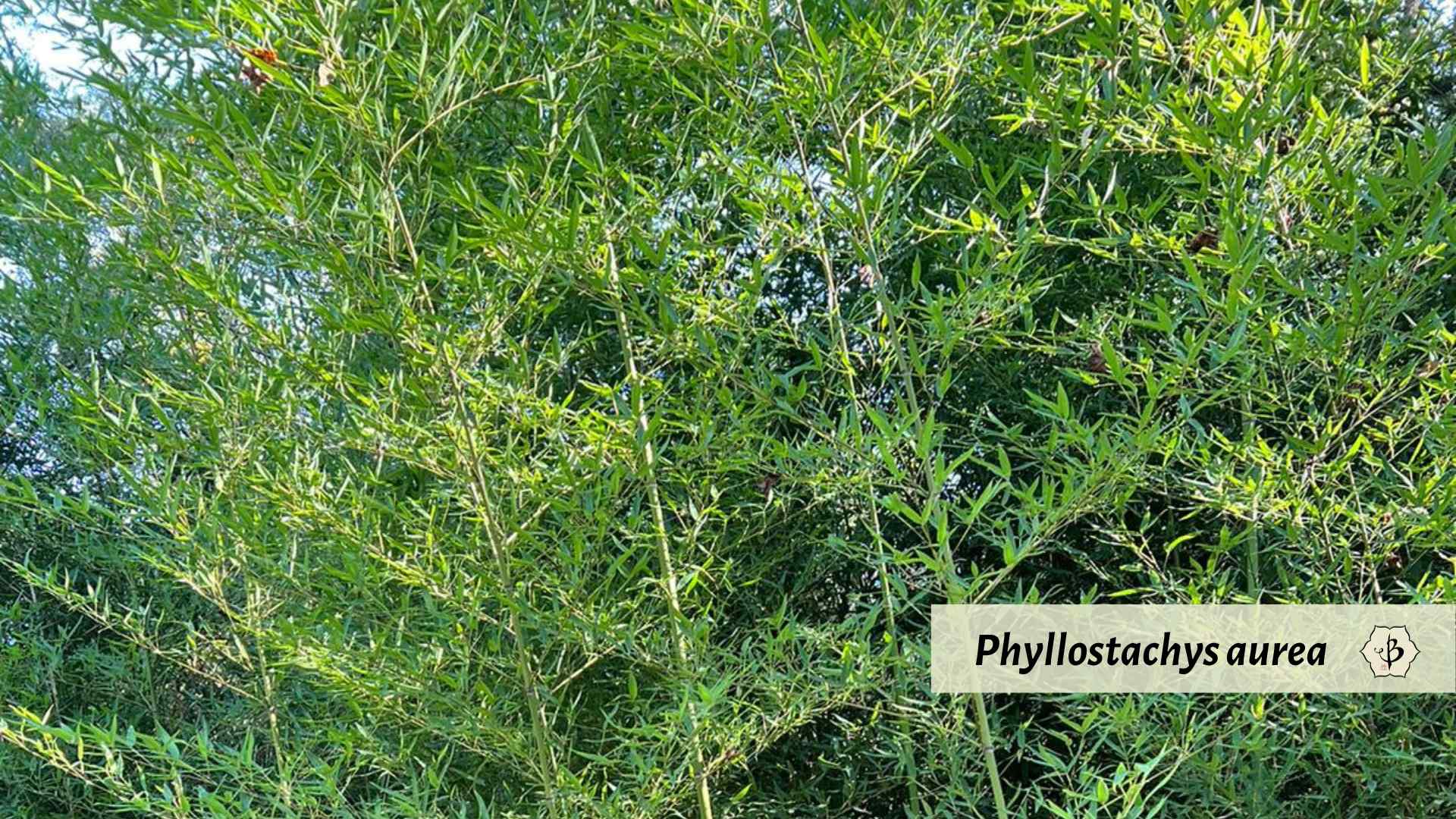
Phyllostachys bissetii: Another very common species, Bissetii is particularly popular as a hedge or privacy screen, and will tolerate all kinds of conditions. It can reach 40 feet tall in ideal circumstances, but 20 to 30 feet is more likely. Attractive, upright culms get up to 2 inches thick, and the plant will survive temperatures as low as -10º F.
Phyllostachys dulcis: This medium-sized species takes its name for the palatability of its shoots. It is roughly Latin for “sweet bamboo”. Young shoots have an interesting, rosy color, and are among the least bitter of bamboo varieties. But I always boil my shoots first and prepare them in something much more flavorful, so I’m really not partial to any particular species. Mature culms grow to 1.5-2 inches in diameter and 20 to 30 feet tall. P. dulcis is a good choice in cool climates with ample rainfall.

Phyllostachys flexuosa: An uncommon but interesting variety, sometimes called Zig-zag bamboo or Drooping Timber bamboo. Slender canes grow 20-30 feet tall. Once they reach full height, the tops tend to arch over, hence the name. The culms are all surprisingly flexible. Also, some of them will grow with a zigzag pattern, but not as pronounced as with Spectabilis. Cold hardy to -10º F.
Phyllostachys glauca: This is a beautiful bamboo variety, with bright green culms that start our blueish green, when the shoots first come up. It is one of the species referred to as a blue bamboo. The culms are elegant and upright, growing up to 20 or 30 feet tall and about 2 inches in diameter. The lower portions of the culms are free of branches, so in this way they resemble some of the taller timber bamboo species.
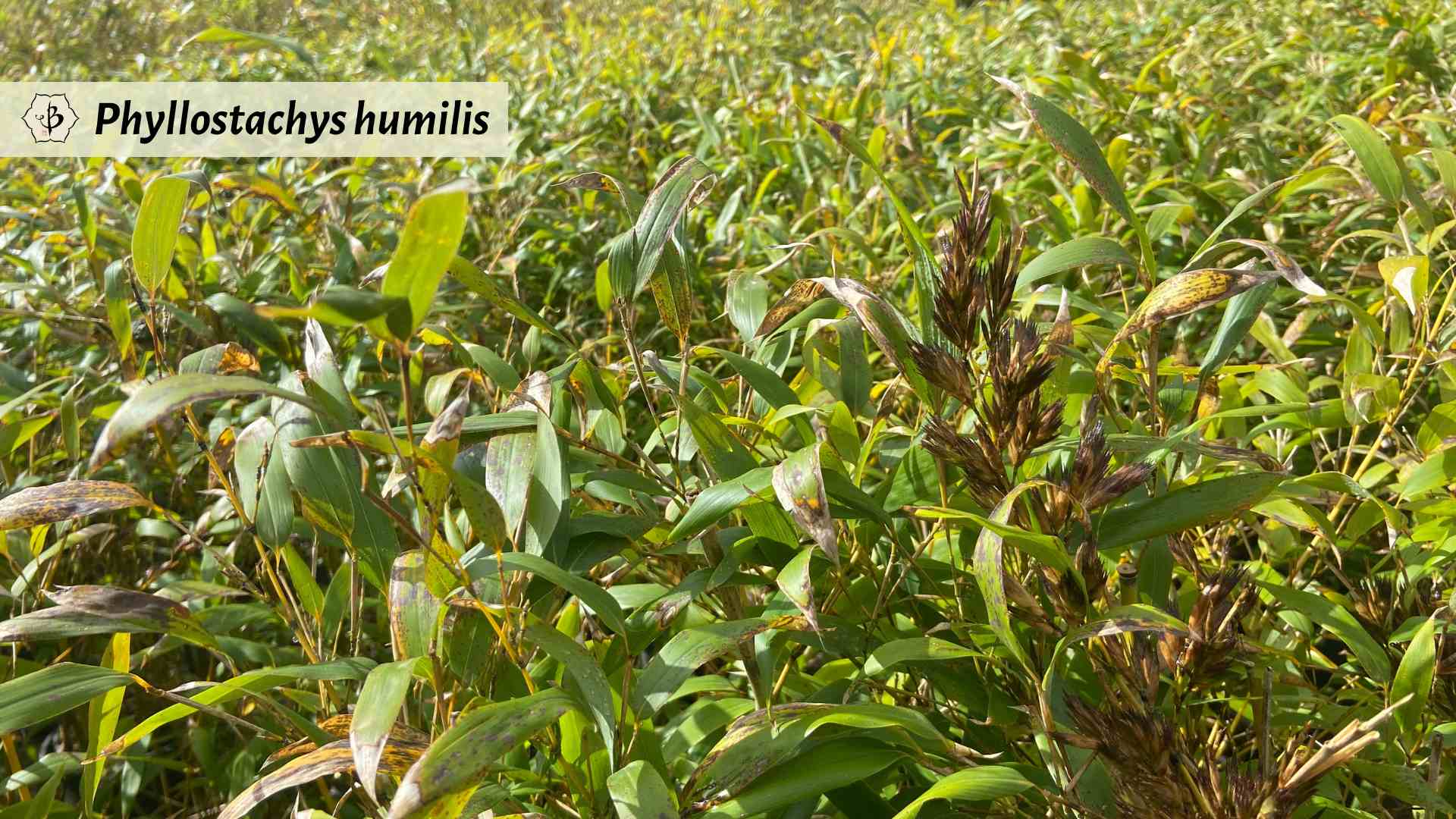
Phyllostachys heteroclada f. solida: This subspecies of “Water Bamboo” is commonly known as “solid bamboo”. In addition to tolerating very wet soil conditions, it’s one of the few varieties with a solid stem, rather than being hollow inside. It’s also a bit more cold-resistant than ordinary Water Bamboo, hardy down to -5 or 10º F.
Phyllostachys humilis is a shorter variety of bamboo but its dense foliage creates an effective, low hedge. Light green culms sometimes take on hues of reddish amber. (I often refer to this species as “Short stachys”, but general audiences have yet to adopt that moniker.)
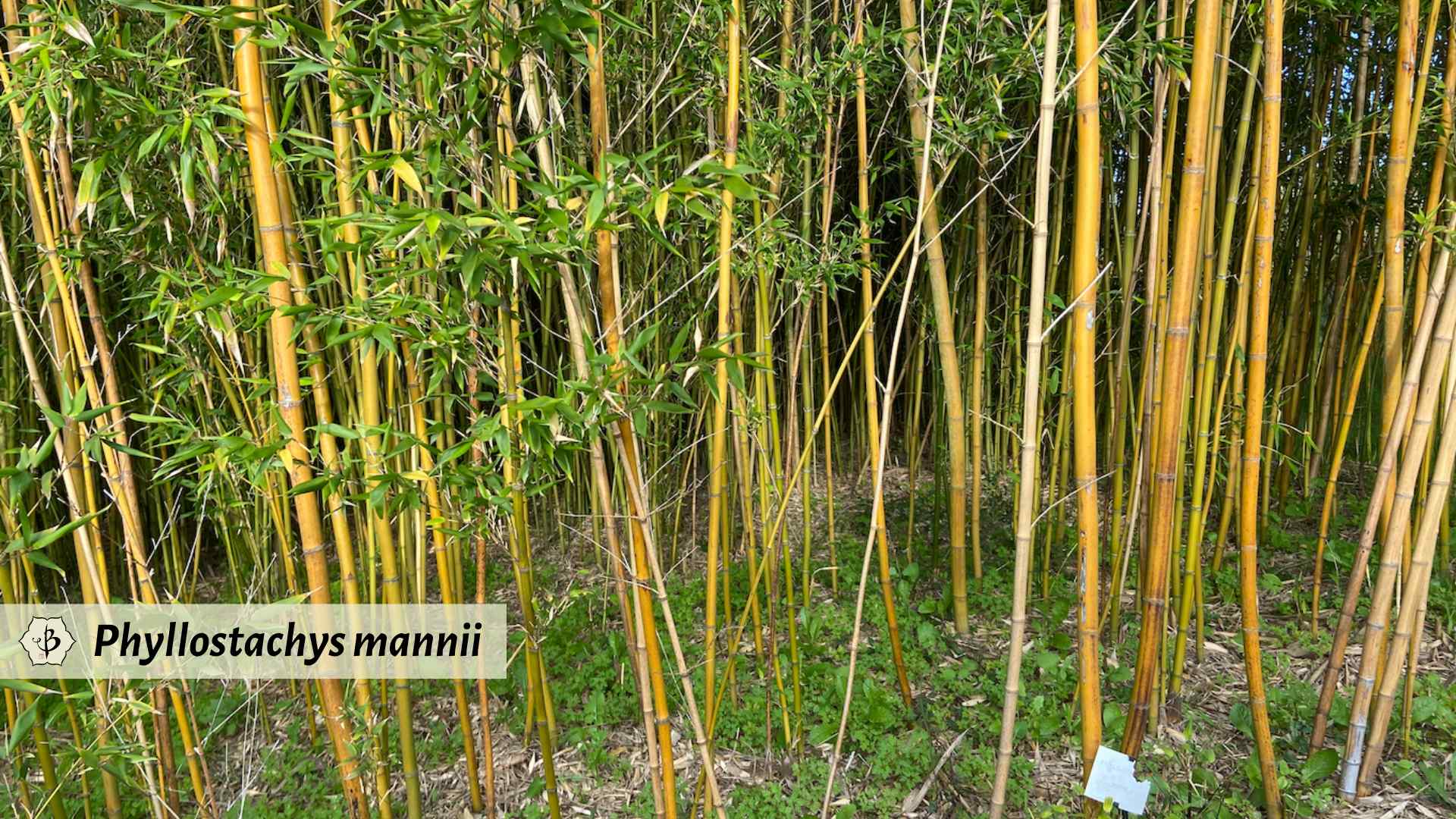
Phyllostachys mannii: Also called ‘Decora’ or Beautiful Bamboo, this medium-sized species can grow 30-40 feet tall with culms up to 2 or 3 inches in diameter. Culms are straight and slender, with colorful culm sheaths that give new shoots an alluring rosy color. Very cold-hardy, down to about -10º F.
Phyllostachys nidularia: Sometimes called Broom Bamboo, this is a rare and unrated species. Growing 30-35 feet tall with culms up to 1.5-2 inches in diameter, it’s a good choice for tall privacy screens or windbreaks. It’s also more adaptable to wet soil conditions, similar to Ph. atrovaginata and Ph. heteroclada. And like these two species, Ph. nidularia is very cold-hardy, down to about 0º F. Strange culm leaves and crooked poles give this bamboo an unusual appearance.

Phyllostachys nigra, or Black Bamboo: The distinctively dark brown (virtually black) shoots make this one of the most highly sought-after strains of bamboo, and any nursery that sells bamboo is likely to have some of this on hand. As the plant matures, the dark color of the culms grows richer, making for a very attractive contrast against the bright green leaves. Unlike the ‘Henon’ cultivar above, this variety only gets about 2 inches thick and 20-30 feet tall. Hardy to about 5º F.
Phyllostachys nuda: A very attractive and cold-hardy species, its shoots get 1-2 inches in diameter and 25-30 feet in height. Young shoots appear very dark, almost black, turning a rich, dark green as they mature, usually with pretty, white rings around the culm nodes.
Phyllostachys parvifolia: Rhizomes of this species are well adapted for wet and saturated soil. Small leaves make the thick, dark green culms stand out, and the white rings around the nodes give them even more character. Many consider the fresh shoots of this variety to be delicious in flavor. Mature shoots can get up to 40 feet tall, and it is extremely cold hardy, down to -15º F.
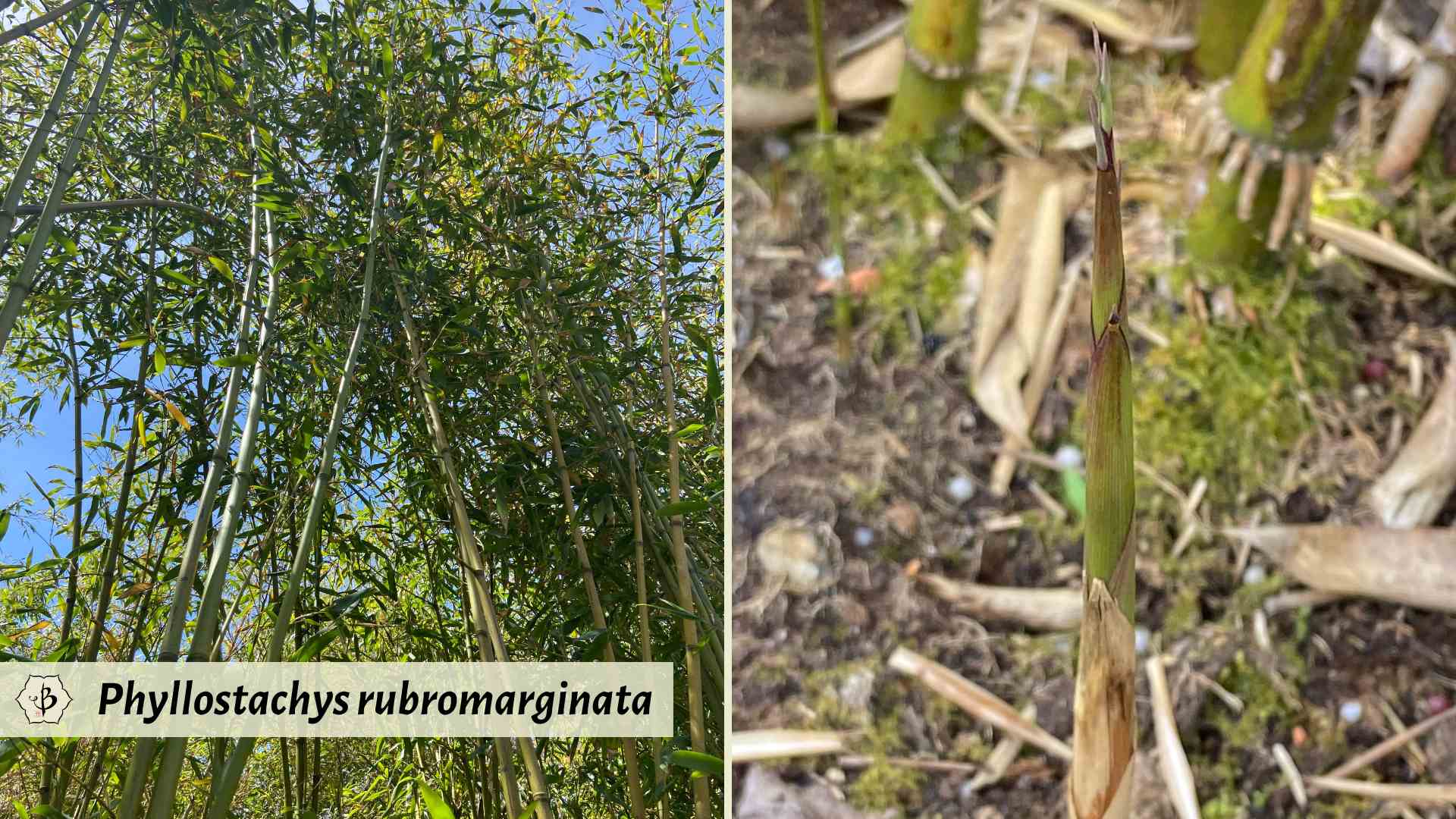
Phyllostachys rubromarginata: Another popular choice for privacy screens, because it fills in so quickly. It’s not quite a timber bamboo, but it’s larger than most, with culms up to 30-40′ tall and up to 3″ thick. A reddish hue on the new shoots has earned it the nickname Red Margin Bamboo. This species also has unusually long internodes, which makes it a good choice for crafts. Cold hardy to about -5º.
Phyllostachys viridis: Tall and statuesque, but slow to spread, this species of bamboo gets about 30-40 feet tall with culms 2-3 inches in diameter. As such, it might be considered a timber bamboo. The cultivar ‘Robert Young’ is especially popular as an ornamental due to the beautiful green stripes on its golden, yellow culms.
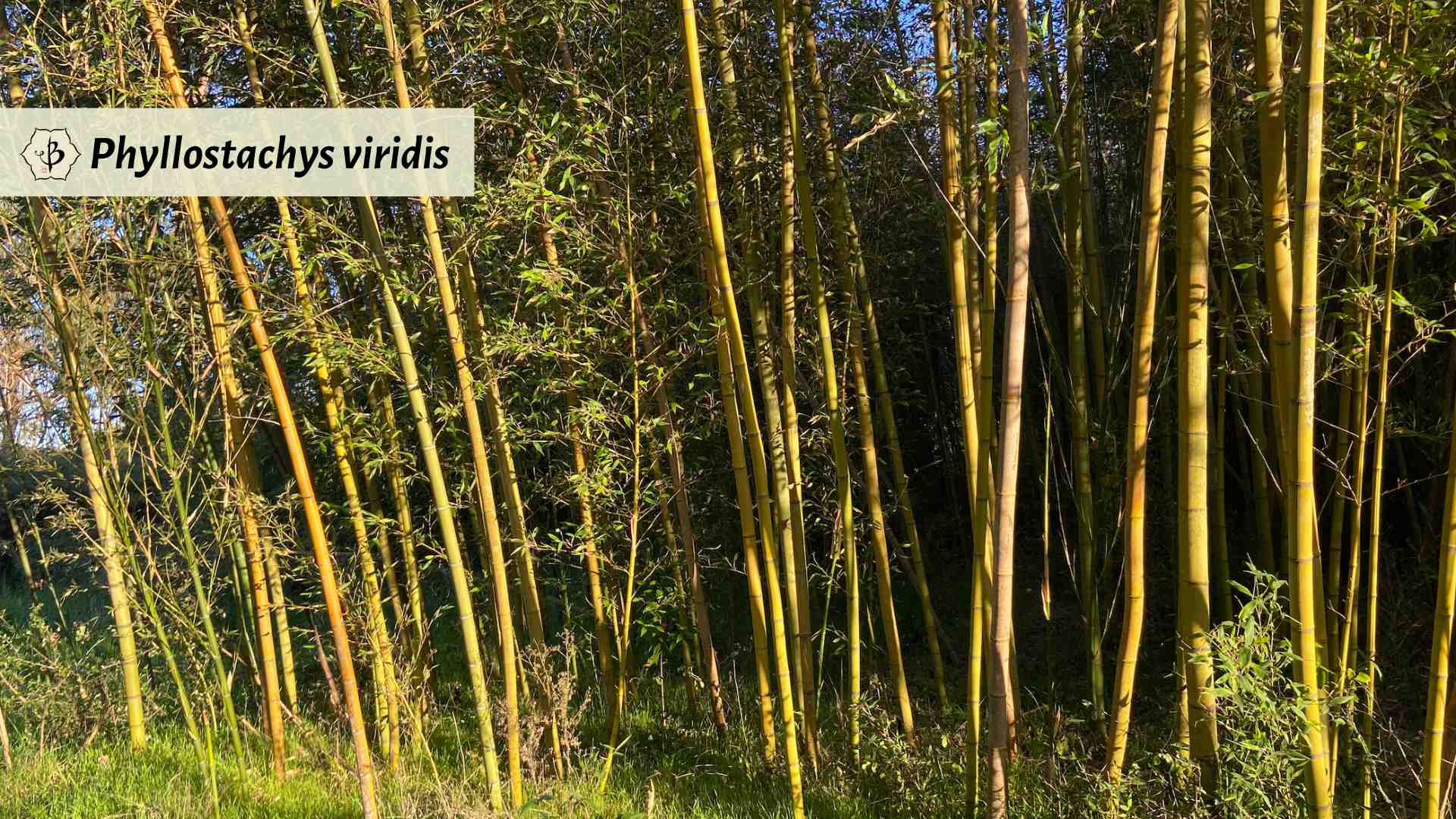
Propagating Phyllostachys
As prolific running bamboo, Phyllostachys are generally quite easy to propagate. The most productive and effective way to do this is by taking rhizome cuttings or by separating and transplanting any culms that still have a good root mass intact. Culm cuttings that work on tropical bamboo like Bambusa and Guadua will not work with Phyllostachys.
Easiest is probably just to dig up some extra segments of rhizome that are showing good health and promising buds. This is best done in the springtime. If you have a well-established Phyllostachys, you’re sure to have an ample supply of rhizomes creeping around your garden. Plant the rhizome sections into pots, rhizomes parallel to the ground with buds pointing upwards. Keep the soil moist, but not soggy, and wait for those buds to start shooting. If you don’t see any shoots, check the drain holes on the bottom of the bottom to look for signs of roots. Not every cutting will take, but you should see some results within a couple of months.
If you really have an abundance of culms in your garden, you can dig up one, or a few of them clustered together. Give the soil a good watering the day before to make sure the plant is in tip-top shape. And be sure to select a vigorous-looking culm. Ideally, it should be less than two years old. Dig carefully to keep the roots intact. You might have to use clippers or even a saw to separate the root mass from the rest of the rhizome network. Then place the root ball into an appropriately sized pot and cover it with good, rich soil. Again, keep the soil moist but not water-logged.
When you have a healthy, fast-growing bamboo that’s determined to spread, you may as well propagate some cuttings. Potted bamboo saplings make great gifts, or you could even sell them, at your local flea market, for example.

Further reading
If you’d like to learn more about the many uses and varieties of bamboo, take a look at some of our most popular articles.
- Growing Bamboo: The complete how-to guide
- Best bamboo varieties for your garden
- Bamboo containment tips
- Preparing your bamboo for winter
- Bamboo anatomy: 9 parts of the bamboo plant
FEATURE IMAGES: Clockwise from left: Typical Phyllostachys branching. Moso skyscrapers, and running rhizome of Phyllostachys viridiglaucescens. (Photos by Fred Hornaday)


























Very informative I appreciate the time and effort put into this to help me be aware of the different varieties cause I thought bamboo was bamboo
Thanks, Joseph. Glad we could help!
Fred,
I am a property manager at sleepy cat farm in greenwich, Ct. WE have a running bamboo here that we maintain as an informal hedge. It has a rhizome barrier. Can we prune it as a hedge to keep it from flopping? Maintain it at 12-15 ft?
Thank You.
Alan Gorkin
Yes, Alan, you can prune it.to keep the bamboo shorter and flatter on top. In most cases this will promote a lot more lateral branching, which should result in a denser hedge, even if the individual culms may look somewhat less elegant.
Very useful bamboo info – thanks.
I know some types of bamboo, especially the shoots, contain cyanide compounds. Are there bamboo plants in the genus Phyllostachys that are toxic to animals? Specifically, if cattle had access to a bamboo grove is there anything in the leaves or shoots that would present a toxicity concern?
Great question, Craig. No, there’s not enough toxicity for this to be a concern for animals. Take a look at this article.